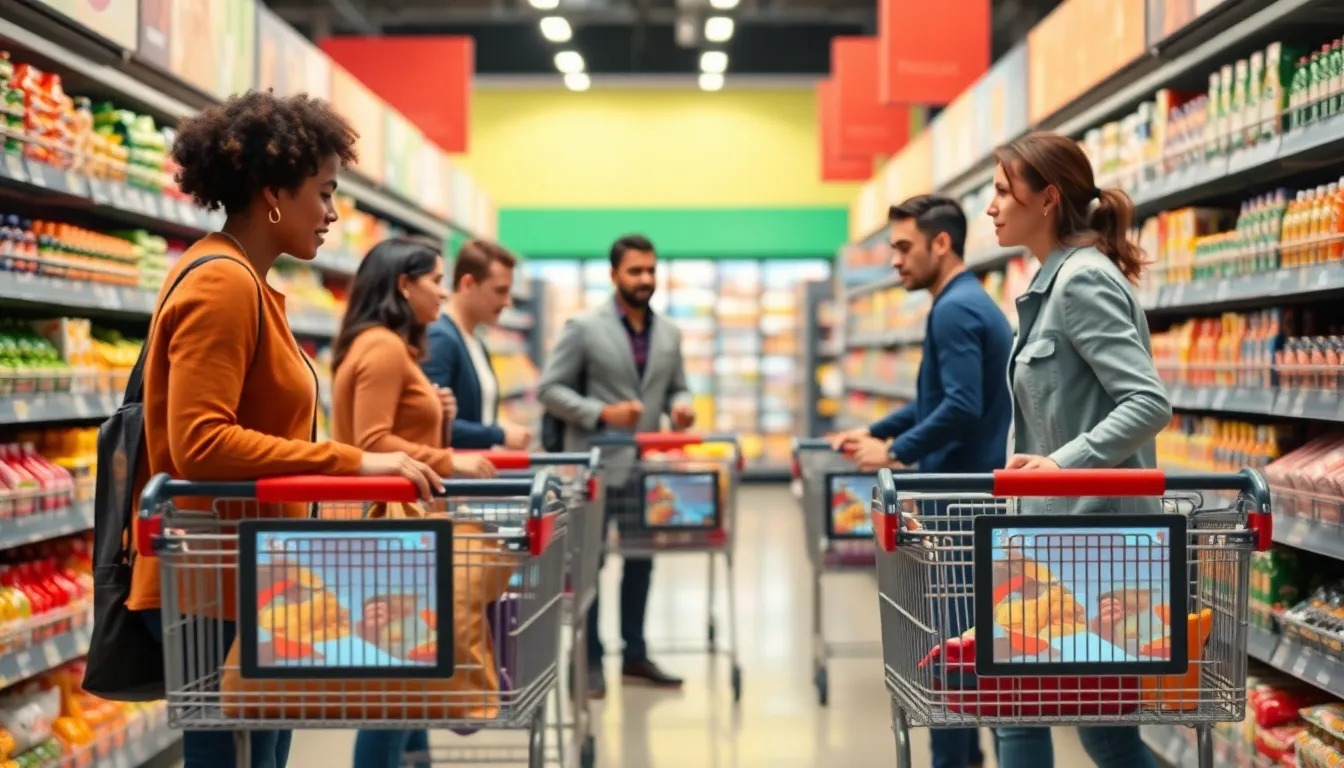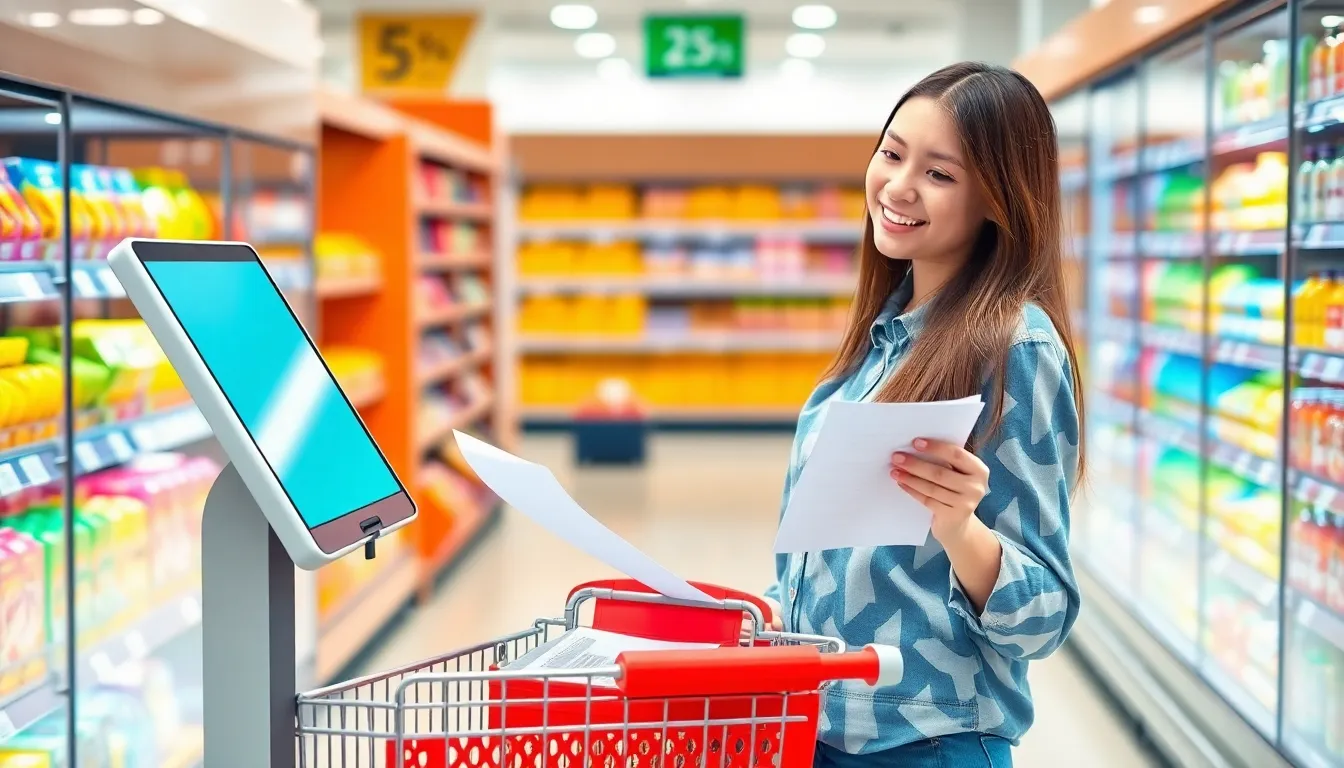Imagine wheeling through the grocery store with a cart that not only carries your snacks but also whispers sweet deals into your ear. Welcome to the world of smart shopping carts, where technology meets your grocery list in a match made in retail heaven. These high-tech carts are designed to transform mundane shopping trips into a delightful adventure, saving time and money while making you feel like a savvy shopper extraordinaire.
Table of Contents
ToggleOverview of Smart Shopping Carts
Smart shopping carts transform the grocery shopping experience through advanced technology. They offer features designed to enhance convenience, efficiency, and enjoyment while shopping.
Origin and Development
Smart shopping carts emerged in the early 2010s as retailers sought to innovate the shopping experience. Companies like Caper and Amazon introduced technology that turned ordinary carts into interactive guides. They began integrating features such as touch screens and barcode scanners, allowing shoppers to track spending in real-time. Retailers adopted these carts to improve customer engagement and streamline operations. Technological advancements continued evolving the functionalities, and now smart shopping carts boast capabilities like GPS navigation and personalized promotions.
Key Features
Smart shopping carts include several innovative features, enhancing the shopping experience. Touch screens allow users to view current deals and personalized shopping lists. Built-in scales enable automatic tracking of item weights and costs. Users benefit from in-cart GPS systems, providing directions to items based on their store layout. Some models offer mobile payment options, allowing for seamless checkout. Real-time inventory updates prevent customers from searching for out-of-stock items, ensuring a more efficient shopping trip. Enhanced user interfaces can personalize recommendations, providing tailored savings and deals as customers shop.
Benefits of Smart Shopping Carts

Smart shopping carts enhance the overall grocery shopping experience by providing various benefits that streamline the process.
Enhanced Shopping Experience
Technology integration in smart shopping carts improves user experience significantly. Customers enjoy interactive touch screens that display product information and personalized recommendations. Features such as barcode scanners allow shoppers to compare prices and verify deals instantly. Real-time updates on store inventory prevent frustrations associated with out-of-stock items. GPS navigation aids in locating products efficiently, making the shopping journey seamless. Engaging with these high-tech carts transforms mundane shopping into an enjoyable adventure, bringing a modern twist to traditional grocery visits.
Time-Saving Advantages
Time efficiency becomes a major advantage of using smart shopping carts. Real-time tracking of spending keeps budgets in check, reducing the time spent at checkout. Built-in scales automatically track item weights and costs, eliminating lengthy manual calculations. Users save significant time searching for items, thanks to GPS features guiding them directly to products. Mobile payment options further expedite the purchase process, allowing instant checkouts. Shoppers can complete their errands quickly, maximizing their time and convenience during busy schedules.
Technology Behind Smart Shopping Carts
Smart shopping carts utilize advanced technology to enhance the shopping experience. These innovations streamline the process while providing valuable information to shoppers.
RFID and Barcode Scanning
RFID technology allows for automated tracking of items in the cart, enabling swift checkout. Barcodes, on the other hand, facilitate accurate pricing and inventory management. Shoppers scan items as they add them to the cart, ensuring they stay aware of total costs. Integration of these technologies reduces human error in pricing and inventory; thus, creating a seamless shopping environment. Retailers benefit as well since they can monitor inventory levels in real-time. Both systems enhance customer experience by eliminating traditional checkout lines.
Integration with Mobile Apps
Mobile apps complement smart shopping carts by offering a personalized shopping experience. Shoppers access customized lists and recommendations directly from their smartphones. Integration ensures that users can track their spending and manage grocery lists efficiently. Notifications about discounts and promotions increase shopping convenience since shoppers receive real-time updates. Syncing with store inventory helps customers locate items, reducing frustration during the shopping trip. This interconnected experience fosters loyalty and encourages repeat visits.
Challenges and Limitations
Smart shopping carts face several challenges and limitations that affect their widespread adoption.
Cost Considerations
Investment in smart shopping carts can be significant for retailers. Initial costs include purchasing the carts themselves and integrating technology, such as RFID and barcode scanners. Ongoing maintenance expenses also impact profitability and efficiency. Budget constraints often lead retailers to weigh the benefits against these costs. Many smaller grocery stores may find it harder to adopt this technology compared to larger chains that can support the investment easily.
User Acceptance
User acceptance presents another challenge for smart shopping carts. Shoppers accustomed to traditional carts may hesitate to use new technology due to unfamiliarity. Fear of technology often deters potential users from fully embracing smart carts. Moreover, users must feel confident in their ability to navigate features like touch screens and mobile payment options. Retailers need to provide adequate training and support to improve user experiences, ensuring shoppers feel comfortable and engaged with the technology.
Future of Smart Shopping Carts
The future of smart shopping carts holds exciting possibilities as technology continues to evolve. Retailers are exploring advanced features to improve customer experiences.
Innovations on the Horizon
Smart shopping carts may integrate artificial intelligence for enhanced personalization. Shoppers could receive tailored promotions based on purchase history and preferences. Augmented reality may guide users within stores, providing interactive paths to locate items efficiently. Voice recognition technology could further simplify navigation, allowing customers to communicate directly with carts. These innovations aim to streamline the shopping experience and foster higher engagement.
Potential Market Growth
Market analysts predict significant growth in the smart shopping cart sector, likely to surpass USD 1 billion by 2025. Increased consumer demand for convenience and efficiency drives this upward trend. As retailers recognize the value of integrating technology, adoption rates are expected to rise. Innovations in cart design and functionality will attract not only grocery chains but also specialty stores looking to enhance customer interaction. This potential market growth signals a bright future for smart shopping carts, transforming them into integral components of the retail landscape.
Smart shopping carts represent a significant leap forward in enhancing the grocery shopping experience. By seamlessly integrating technology into everyday tasks, these carts not only streamline the shopping process but also empower consumers with valuable information at their fingertips. As retailers continue to innovate and address challenges around cost and user acceptance, the potential for smart shopping carts to revolutionize the retail landscape is immense. With advancements on the horizon, shoppers can look forward to even more personalized and efficient experiences in the aisles. The future of grocery shopping is bright, and smart carts are leading the way.




